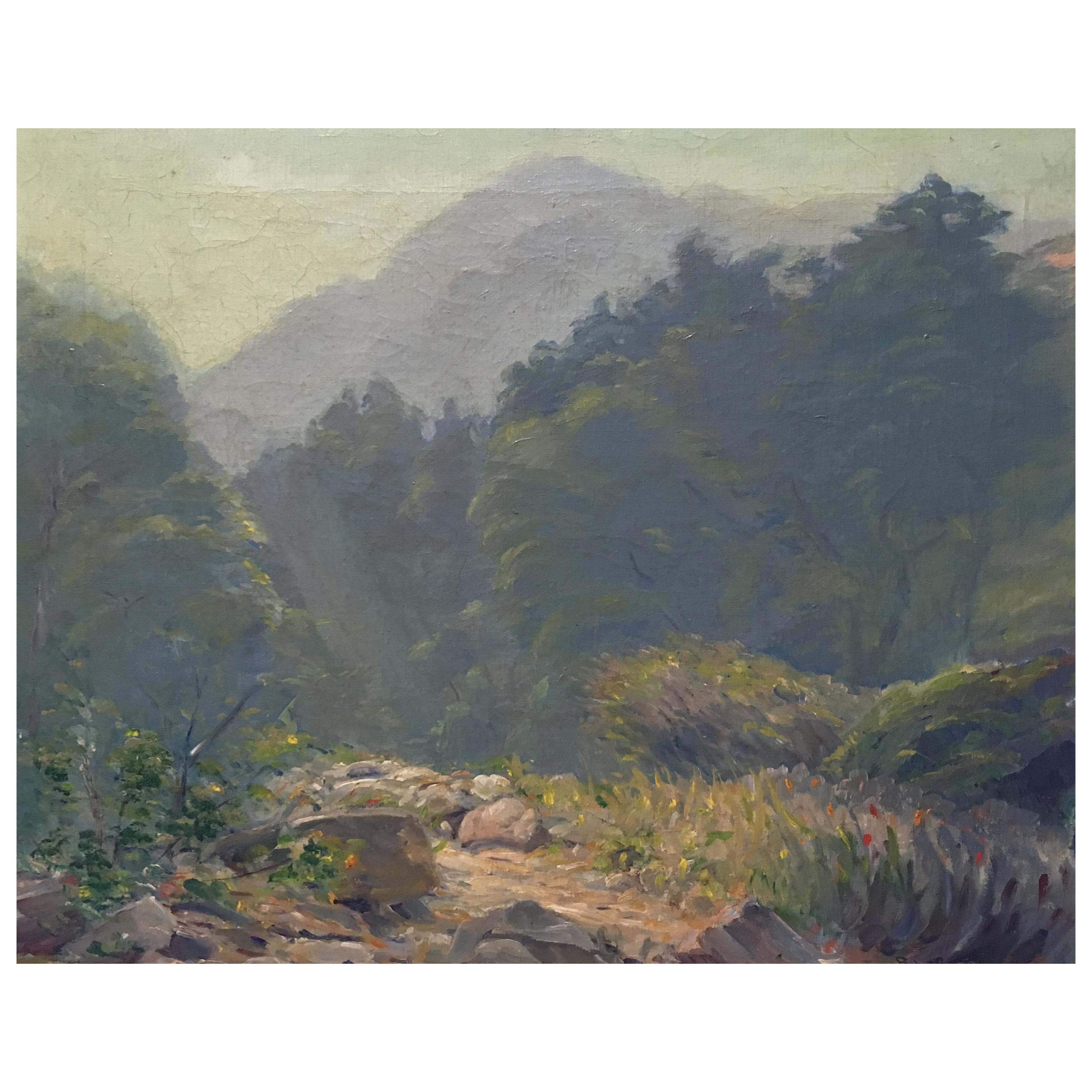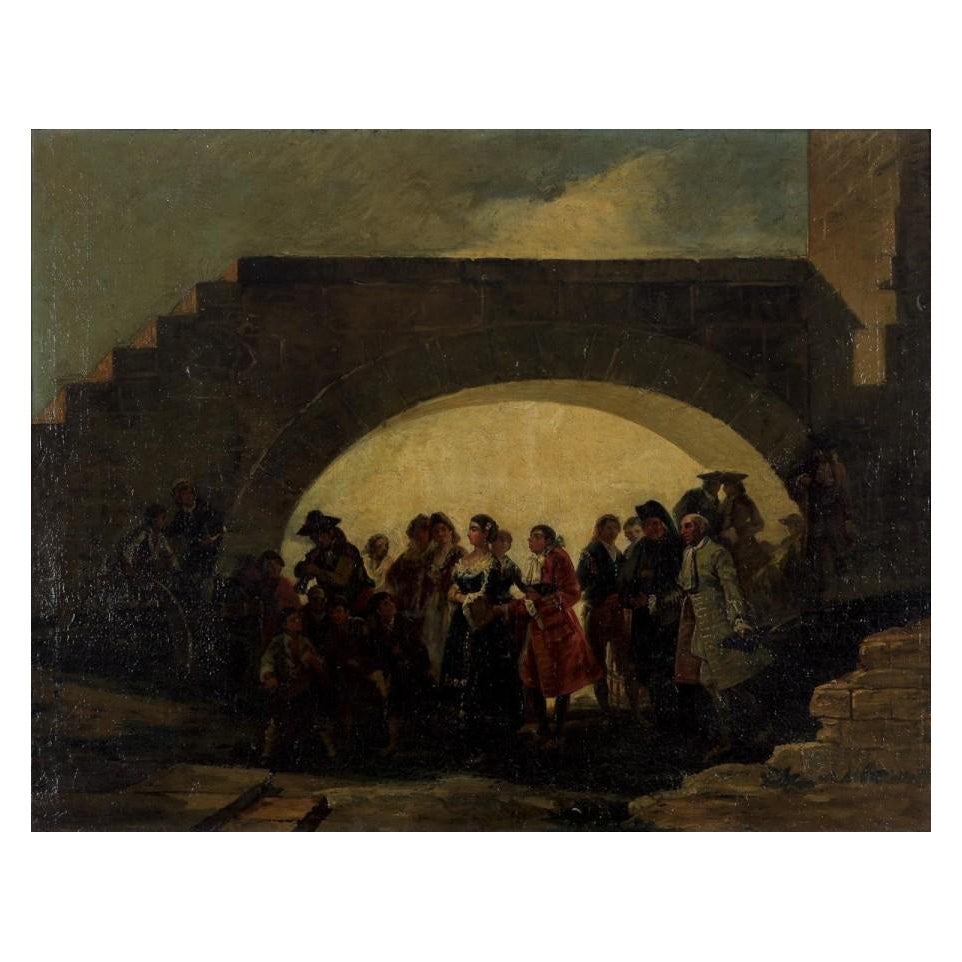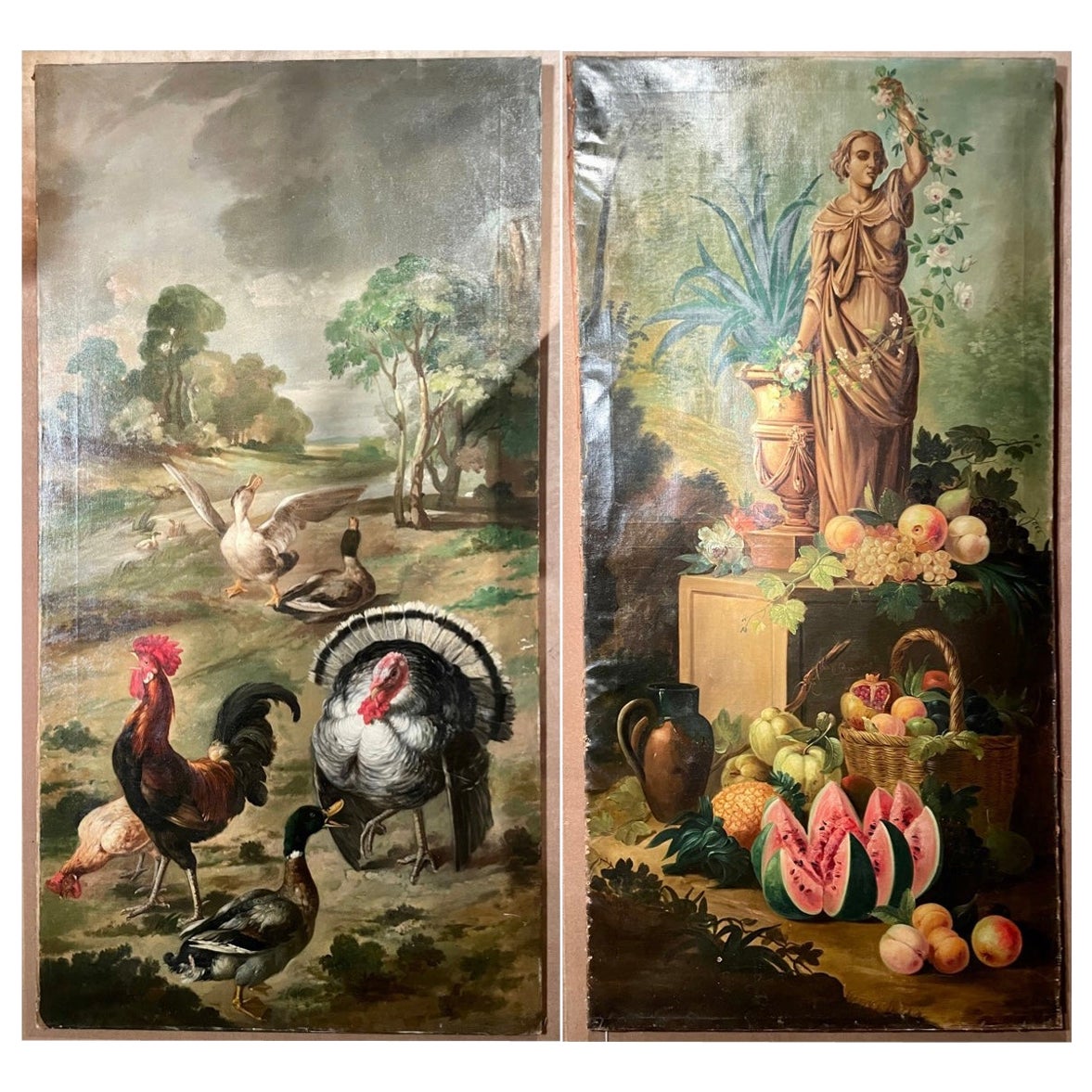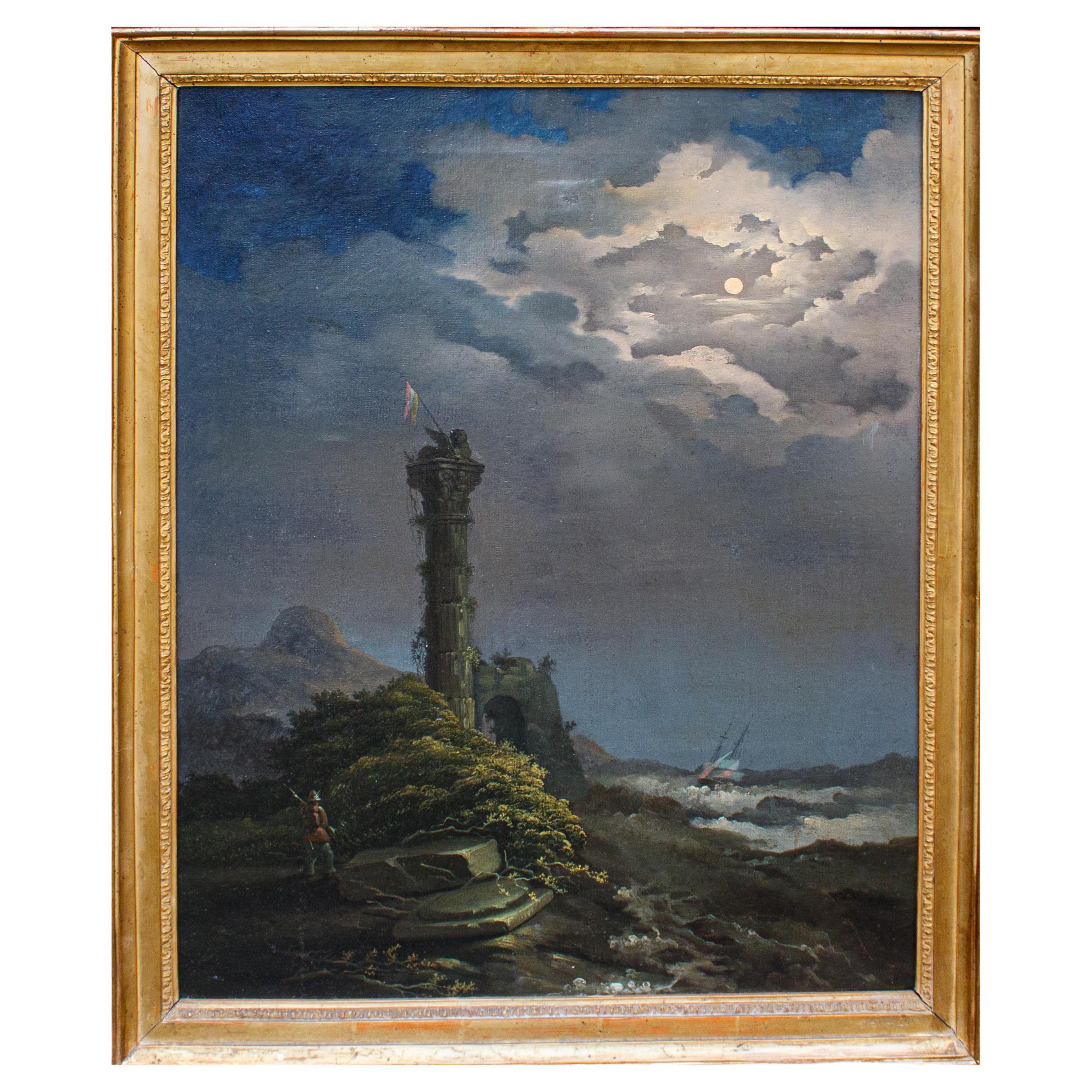Items Similar to 19th Century The Betrothed Painting in Oil on Panel by Guglielmo Napoli
Want more images or videos?
Request additional images or videos from the seller
1 of 11
19th Century The Betrothed Painting in Oil on Panel by Guglielmo Napoli
About the Item
Guglielmo Napoli (Pavia, 1868 - Genoa, 1945)
The betrothed
Oil on panel, 46.6 x 68 cm
Frame 73 x 81 cm
Signed lower left "Gugl . mo Napoli Dipinse"
The work in question takes up a gallant scene set in a garden with a neoclassical taste. The wooded landscape characterizes the scene, with the green tones of the shrubs, and envelops the figures, intent on taking a walk in the park of the villa that can be glimpsed in the distance. The noblewomen are dressed in day dresses, in pastel, light and fluttering colors that are well suited to the bucolic context of the landscape; a man, on the other hand, accompanies the young women to discover the secrets of the wood, perhaps the old father or a page. The joyful gang is taken up by the painter in a moment of daily leisure, giving a testimony of the high bourgeois life of the girls of the time, marked by outdoor activities, games, walks, chat with friends.
Guglielmo Napoli was a painter trained at the Pavia School of Art. In 1891 he participated in the Exhibition of the Promoter of Genoa with the painting "Study from life". From the last years of the nineteenth century he settled in Genoa where he studied. In 1892 he participated in the Exposition for the Colombian Celebrations. His participation in the Promotional Exhibition of Fine Arts in Genoa in 1900 with the painting "Surroundings of Novi Ligure" and in the Social Exhibition of Fine Arts of 1918 with the painting "Portrait" is documented. Among his best-known works, the portraits of “Richard Wagner” and “Giuseppe Verdi” currently preserved in the Pinacoteca Civica of Imperia are worthy of mention - coming from the Rebaudi legacy.
- Dimensions:Height: 28.75 in (73 cm)Width: 31.89 in (81 cm)Depth: 1.97 in (5 cm)
- Materials and Techniques:
- Place of Origin:
- Period:
- Date of Manufacture:19th Century
- Condition:Wear consistent with age and use.
- Seller Location:Milan, IT
- Reference Number:1stDibs: LU5918226540152

About the Seller
5.0
Vetted Seller
These experienced sellers undergo a comprehensive evaluation by our team of in-house experts.
Established in 2000
1stDibs seller since 2021
26 sales on 1stDibs
Typical response time: 12 hours
- ShippingRetrieving quote...Ships From: Milan, Italy
- Return PolicyA return for this item may be initiated within 14 days of delivery.
More From This SellerView All
- 19th Century Cloister Painting oil on canvas by Achille BattistuzziLocated in Milan, ITAchille Battistuzzi (Trieste 1830 - Barcelona, ??1891) Cloister Oil on canvas, 51x67 cm - with frame 74 x 89 Signed lower right "A. Battistuzzi" Achille Battistuzzi (Trieste 18...Category
Antique 19th Century Italian Paintings
MaterialsCanvas
- 19th Century Moonlit Landscape Painting Oil on CanvasLocated in Milan, IT19th century Moonlit landscape Measures: Oil on canvas, 67 x 51.5 cm With frame 75 x 59 cm Signed lower left “Luigi Giavazzi” The landscape illuminated by the nocturnal light of the moon that illuminates the sky depicts a collision between natural elements: if on the one hand we find the luxuriant hilly landscape with the rocks covered by shrubs and the grotesque tower with the lion of San Marco...Category
Antique 19th Century Italian Paintings
MaterialsCanvas
- 19th Century Portrait of Tiziano and Rembrandt Couple of Paintings Oil on CanvasLocated in Milan, IT19th century Portrait of Tiziano Vecellio and Rembrandt Measures: (2) Oil on canvas, 25 x 18.5 cm Frame 46 x 37 cm The two portraits depicting the artists Tiziano Vecellio and Rembrandt are to be counted among the reproductions of those famous self-portraits made by the two painters throughout their careers. As far as Titian is concerned, the artist creates numerous self-portraits that shoot him in different ages of his life and in different poses from time to time. An example is the one kept in the Prado Museum (Tiziano Vecellio, Self-portrait, 1560, oil on canvas, 86 × 65 cm, Museo del Prado, Madrid), which portrays the now elderly master, as in the present case. The thick white beard reaches almost to the chest, depicted almost in profile, while here the bust is frontal and the face turned three-quarters; his gaze is then turned to the outside of the painting and his expression seems tired and thoughtful. The broad forehead is uncovered and cut by a tight black bonnet from which no hair comes out. A thin white collar separates the face from the rest of the body dressed in an elegant and sober black dress, just like in this portrait. The figure clearly emerges from the background devoid of objects or furnishings, so that nothing distracts our gaze from the image of the famous artist who thus wants to be remembered. Another example is the self-portrait in Berlin (Self-portrait, 1552, 96 x 75 cm, Staatliche Museen, Berlin), which depicts the elderly artist, but decorated with a rich dress and placed in a physical space. Finally, the lost self-portrait in oil on paper, cited by Vasari in his Lives in 1545, keeps a low profile, as evidenced by the rather modest dress...Category
Antique 19th Century Italian Paintings
MaterialsCanvas
- 18th Century Portraits of Women Couple of Paintings in Oil on Canvas by BertoliLocated in Milan, ITAntonio Bertoli (active between 1829 - 1842) Portraits of women (2) Oil on canvas, 41.5 x 31 cm With frame 52 x 42.5 cm Signed below A. Bertoli The two portraits examined here are by the hand of the artist Antonio Bertoli, a painter active in Florence between 1829 - 1842. He trained at the Florentine Academy, where in 1832 he obtained the prize for the nude in drawing. At the academic exhibitions of the following years he exhibited mainly portraits, including a representation of Nicolò Macchiavelli executed in 1837. An eclectic artist, he experimented with different genres: for the Villa Puccini di Scornio in Pistoia, in 1838, he was commissioned to create a history picture, The death of Francesco Ferrucci (Pistoia, Civic Museum), inspired by an episode of the novel Siege of Florence by Francesco Domenico Guerrazzi. Instead, two religious paintings date back to the 1840s: Christ chasing the merchants from the Temple and a Virgin Mary, In the portraits analyzed Bertoli depicts two half-length women taken from a foreshortening and a frontal in close pose, characterized by very similar Mediterranean features. In the first painting the woman, taken from the front, looks directly at the viewer. The wavy hair is decorated with a colorful violet and is partially covered by a white veil...Category
Antique 19th Century Italian Paintings
MaterialsCanvas
- 17th Century Christ and the Samaritan Oil on Canvas Roman SchoolLocated in Milan, ITRoman school of the 17th century Landscape with bridge - Christ and the Samaritan woman at the well Oil on canvas, cm 42 x 59,5 - With frame, cm 54, 5 x 71 cm The small canvas portrays a broad view of the city surrounded by a bucolic and lush landscape, probably a reinterpretation of the Roman countryside or the Agro. The fulcrum of the canvas is the bridge consisting of several bays beyond which stands a village. In the distance the landscape made of green mountains opens into what looks like a lake crossed by boats. The landscape is animated by the human presence; not only small and fleeting figurines intent on walking along earthy paths but also the representation, in the foreground, of an Gospel episode, that of Christ and the Samaritan woman at the well. The landscape can be clearly traced back to a painter trained on the examples of the great seventeenth-century Roman baroque landscape that sees in the Lunette Aldobrandini by Annibale Carracci but also in Claude Lorrain, Nicolas Poussin and Gaspar Doghet are its greatest achievers. If in the past, therefore, the landscape was considered the scenic background on which to project the representation of divine or human characters, in the seventeenth century it became an autonomous and codified pictorial genre. With Carracci comes the so-called ideal landscape: a mental reconstruction of a peaceful and harmonious nature in which the dream of a perfect communion with man is realized. In the wake of Hannibal, as mentioned, during the seventeenth century the "classic" Roman landscape knows a long and happy season by artists such as Domenichino, and the French Claude Lorrain, Nicolas Poussin and Gaspar Dughet. Lorrain investigates the Roman countryside in all its aspects, studying the variations in the different hours of the day, the seasons or weather conditions, but always nourished by a sense of bucolic Virgilian. With Poussin the approach becomes intellectual elaboration and sophisticated rational construction. From the examples of the great masters, the Roman Baroque season, from the middle of the century, saw the flourishing of several personalities who, with shots, but also important personal reworkings, led to further spread the genre. Among the personalities that can be compared to the work in question we cannot fail to mention Crescenzio Onofri (1634-1714), defined by Salerno as the only true pupil of Dughet, who then spread in Florence the taste of the Baroque landscape influencing Tuscan painters such as Panfi and Peruzzini. His paintings are in various Roman collections; such as, for example, the landscapes from the Sacchetti Collection and today at the Pinacoteca Capitolina. and those in the Almagià collection in Rome, others in the Palazzo di Montecitorio, but the most conspicuous group is in the Galleria Doria. In comparison we can mention the two passages of the National Gallery in London, the landscape with a bridge over the Antiquarian Market but also the design of the National Gallery of Art in Washington. In the work you can also find the influences of the art of Giovanni Francesco Grimaldi...Category
Antique 17th Century Italian Paintings
MaterialsCanvas
- 17th Century Madonna with Child Painting Oil on Canvas Tuscan SchoolLocated in Milan, IT17th century, Tuscan school Madonna and Child Oil on canvas, 31 x 21 cm With frame, cm 37,5 x 27,5 The pearly incarnations and the thoughtful play of looks between the Virgin, turned to the Son, and Questi, warmly open to the viewer, pour out the present painting with compositional perfection. Virginal fabrics become mottled at the folds, wrapping the Madonna in a thin vitreous mantle. The pastel colors, shining on the pink robe just tightened at the waist by a gold cord, enliven the faces of the divine couple in correspondence of the cheeks, lit by an orange warmth. Even the left hand of the Virgin, composed in perfect classical pose (Botticelli, Madonna with Child, 1467, Musée du Petit Palais, Avignon), is sprinkled with warmth thanks to the immediate touch with Christ. From the nimbus of the Mother a delicate luminous disk is effused, which takes back, in the most distant rays, the colour of the hair of the Son, from the tones of the sun. The Child Jesus is represented intent in a tender gesture of invitation with the right hand, while with the other he offers a universal blessing: with his hand he retracts the index and annular palms, extending the remaining three fingers, symbol of Father, Son and Holy Spirit. The painting welcomes and re-elaborates that typically Tuscan formalism that boasted in the rest of Italy the constant appreciation by the most up-to-date artists and collectors. Arrangement, composition and mixing of colors place the canvas in the middle between the changing mannerist and the sculptural figures of Michelangelo, essential yardstick of comparison in terms of anatomical and expressionistic rendering. In the present, silvery and pinkish powders act as three-dimensional inducers to the Child’s mentioned musculature and to the vivid folds of the clothes, expertly deposited on the lunar whiteness of the skins. While these colours recall the equally brilliantly transparent colours of Pier Francesco Foschi...Category
Antique 17th Century Italian Paintings
MaterialsCanvas
You May Also Like
- California Oil on Canvas Painting, 19th CenturyLocated in Cypress, CACalifornia oil on canvas landscape painting, "Evening Glow" - Otto Robert Gaensslen (1876-1915; American) Late 19th-early 20th century. Artist Bio: ...Category
Antique Late 19th Century American Paintings
MaterialsCanvas
- 19th Century "the Wedding" Oil on Canvas Painting by Eugenio Lucas VelázquezLocated in Marbella, ES19th century "La Boda / The Wedding" oil on canvas painting by Eugenio Lucas Velázquez (1824-1870). The scene represent a wedding under a bridge with eve...Category
Antique Mid-19th Century Spanish Paintings
MaterialsCanvas, Wood
- Pair Antique 19th Century French Oil on Canvas Painting Wall Panels, circa 1880Located in New Orleans, LAPair antique 19th century French oil on canvas painting wall panels, circa 1880.Category
Antique Late 19th Century French Decorative Art
MaterialsCanvas, Paint
- 19th Century Oil on Wood Sea Landscape PaintingLocated in Marbella, ES19th century oil on wood sea landscape painting. Signed.Category
Antique Late 19th Century European Paintings
MaterialsWood
- Matteo Lovatti 19th Century Oil on Panel Young Prince's VisitBy Matteo Lovatti 1Located in Los Angeles, CAMatteo Lovatti (Italian, b. 1861) a fine 19th century oil on panel "The Young Prince's Visit" Depicting an interior tavern scene with a jester introducing and welcoming a young Princ...Category
Antique 19th Century Italian Baroque Revival Paintings
MaterialsWood
- 19th Century French Shool, Cupid & Psyche, Oil on Panel, FramedLocated in Leuven , BEThis 19th century oil on canvas depicts the first kiss between Cupid and Psyche. It symbolizes the moment of innocence right before the sexual awakening happens. The two characters a...Category
Antique Late 19th Century French Paintings
MaterialsHardwood
Recently Viewed
View AllMore Ways To Browse
Antique Oil Painting On Wood Panel
Oil Painting Man 19th Century
Oil Painting 19th Century Man
19th Century Oil Painting Girl
Antique Women Dresses
Outdoor Panel
Old Document
Suit With Train
Flutter Dress
Neoclassical Wall Panels
Neoclassical Wall Panel
Antique Promotion
Set Outdoor Wall
19th Century Portrait Young Man
Portrait Of Young Man 19th Century
Genoa Italy Painting
Outdoor Italian Wall
Decorations For Outdoor Walls





